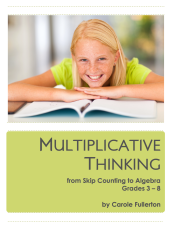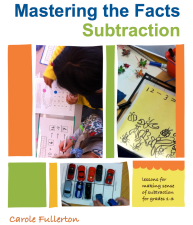Good Questions for Kindergarten & Grade 1
Lessons and Open-ended Tasks for Building Number Sense: A New Resource by Carole Fullerton
Good questions engage students in important mathematics. They inspire and propel students in their learning, offering an entry point for all. What better response could there be for our delightfully diverse early primary classrooms?
This new combined grades resource is built around good questions, drawn from each of the strands in the Kindergarten and Grade 1 curricula. Lessons feature sorting and patterning, shape and measurement and number sense (subitizing, counting, estimating and the operations) in an accessible format for teachers of early primary.
At the end of each set of lesson sequences, a collection of more than 200 open-ended tasks is presented to allow for building, exploration, practice and extension, meeting the needs of all learners.
Have fun! Get inspired! Keep them thinking!
Maintenant disponible en français!
Finally … French translations of my latest books are now available!
Je viens de traduire mes deux ressources de bonnes questions — “A Year of Good Questions for Grades 2-4” et “A Year of Good Questions for grades 5-8” — afin que mes collègues d’immersion aient des ressources françaises avec lesquelles travailler. Merci pour vôtre patience!
In these new French translations of the English originals, you’ll find more than 200 open-ended and engaging problems for french immersion students from primary through middle school. All are posed in French and explore important mathematical concepts across the grades.
 The first book: Bonnes Questions: Une année de bonnes tâches mathématiques pour les élèves de 2e à 4e is suitable for late primary students (grades 2-4) and features operational tasks, measurement tasks and pattern tasks of increasing complexity, posed in French.
The first book: Bonnes Questions: Une année de bonnes tâches mathématiques pour les élèves de 2e à 4e is suitable for late primary students (grades 2-4) and features operational tasks, measurement tasks and pattern tasks of increasing complexity, posed in French.
 The second volume: Bonnes Questions: Une année de bonnes tâches mathématiques pour les élèves de 5e à 8e is perfect for middle school immersion students (grades 5-8), with a focus on proportional reasoning, algebraic thinking as well as operations on integers, fractions and decimals to name a few.
The second volume: Bonnes Questions: Une année de bonnes tâches mathématiques pour les élèves de 5e à 8e is perfect for middle school immersion students (grades 5-8), with a focus on proportional reasoning, algebraic thinking as well as operations on integers, fractions and decimals to name a few.
Engaging problems and choice make these volumes the perfect conversation starter for our immersion classrooms, promoting oral language development and mathematical thinking …en même temps!
All are available from my online store.
Carole
New For Primary! Good Questions: A Year of Open-Ended Problems for Grades 2-4
For those of you who have been waiting ever so  patiently, I wanted to let you know that I have completed a primary companion to the Year of Good Questions for Grades 5-8 resource released this summer.
patiently, I wanted to let you know that I have completed a primary companion to the Year of Good Questions for Grades 5-8 resource released this summer.
A Year of Good Questions for Grades 2-4 is the late primary version of this stand up calendar of problems — one for every day of the school year!
Like its intermediate counterpart, this compact but potent book comes with an easel so you can set it up on your desk and flip from one rich problem to the next, posing open-ended questions of your primary students.

Good Questions: A Year of Open-Ended Math Problems for Grades 2-4 is a problem-a-day resource that includes rich tasks ideal for grades 2, 3 and 4. Organized by topic and structured in problem sets of 5, this simple to use teacher resource includes 200 mathematically important questions to engage your students in deep thinking. For only $25, it’s a reasonably priced way to stimulate and promote mathematical conversation!
Operations, measurement, proportional thinking and patterns are featured in this calendar of problems. Each one engages students in thinking flexibly, critically and creatively to solve tasks of varying complexity.
Visit my online store at mindfull.ecwid.com to order.
Let the fun begin!
Carole
Good Questions: A Year of Open-Ended Problems for Grades 5-8
I am pleased to say that — beyond spending every day on the water this summer — I DID manage to create a new teacher resource for my intermediate colleagues.
This time, it’s a stand up calendar of problems — one for every day of the school year!
This compact but potent book comes with an easel so you can set it up on your desk and flip from one rich problem to the next, posing open-ended questions of your intermediate students.

Good Questions: A Year of Open-Ended Tasks is a problem-a-day resource that includes
rich tasks ideal for grades 5, 6, 7 and 8. Organized by topic and structured in problem sets of 5 or more, this simple to use teacher resource includes 210 mathematically important questions to engage your students in deep thinking. For only $25, it’s a perfect back-to-school gift for yourself!
Proportional reasoning, measurement, operations and algebra are featured in this calendar of problems. Each one engages students in thinking flexibly, critically and creatively in the face of important and challenging mathematics.
Visit my online store at mindfull.ecwid.com to order.
Let the problem-solving begin!
Carole
Addressing Diversity in Math with Open Ended Questions
 Our math classrooms are more and more diverse each year. Learners come to us with a range of different experiences and levels of understanding of the mathematics that’s important to know. Meeting the needs can prove challenging. Dr. Marian Small’s book called Good Questions: Great Ways to Differentiate Mathematics Instruction is an excellent resource for learning how to craft questions to make the math accessible to all – challenging for those who need it, and simplified for others. Check it out for more rich and open tasks to engage children in thinking mathematically across the grades!
Our math classrooms are more and more diverse each year. Learners come to us with a range of different experiences and levels of understanding of the mathematics that’s important to know. Meeting the needs can prove challenging. Dr. Marian Small’s book called Good Questions: Great Ways to Differentiate Mathematics Instruction is an excellent resource for learning how to craft questions to make the math accessible to all – challenging for those who need it, and simplified for others. Check it out for more rich and open tasks to engage children in thinking mathematically across the grades!
This is an incredibly useful teacher resource book. In it, Dr. Small poses open-ended questions across the strands as well as what she terms “parallel tasks”, which present the same math concept at 2 different levels of complexity. It’s a very clever way to include everyone in the mathematical discussion, and can really help when we’re planning for instruction in a combined grade setting. Oh – and did I mention that Marian Small is Canadian?? 🙂 Her work is in line with the WNCP math curriculum and so makes a great match for anyone teaching math here in Canada.
This selection of questions from Dr. Marian Small’s book are ideal for combined grades settings, since they address big math ideas that are common to side-by-side curricula. Invite your students to represent their thinking with models, pictures and words, and to share what they know with a peer, a small group and/or the class. These questions lend themselves to rich classroom discussions, and can give you as a teacher important assessment data to inform your planning.
Enjoy!
Carole
PS – Marian Small has also authored a companion book for secondary math that’s well worth checking out: MORE Good Questions: Great Ways to Differentiate Secondary Mathematics Instruction.
Open-ended Problems for K-4
Last week I gave a session for teachers in Coquitlam looking to teach – and assess – problem-solving. We talked about what made a good problem, both in terms of content and wording, then worked through some samples across the grades. I have posted a selection of problems for you here, which I invite you to download and use with your students.

Remember that it’s important to collect students’ thinking in a variety of forms – numbers, pictures and words, to have them engage with models or manipulatives, and wherever possible to have students communicate their understandings about a concept by translating them to a problem of their own. The latter is no small task! :o) John Van de Walle’s diagram outlines the importance of not only including these representations but also connecting and bridging between them. Students learn deeply when they transform their learning from numbers to models, from words to pictures, from problems to numbers and back again…
Carole










